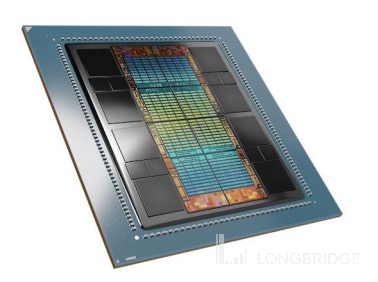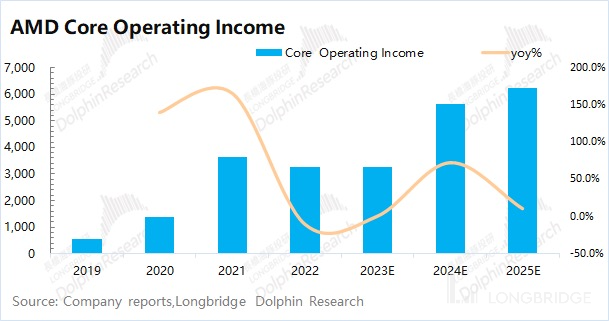
 Likes Received
Likes Received Posts
PostsAMD's AI Dream: Can MI300 Snipe Nvidia?

Similarly situated in the AI computing track, Nvidia's stock price has repeatedly hit new highs, with a rise of 200% from the beginning of the year to the present, while AMD's stock price has not even touched its previous high.
$$AMD(AMD.US) has been holding back, recently releasing the MI300 computing power new product. However, this has not brought a good market response, and the stock price has even fallen frequently. As a follower in the track, it is understandable that AMD's stock price has performed weakly in the early stage. Does AMD still have the opportunity to catch up, given that the company's stock price is still more than 20% away from its previous high?
In the previous article "AMD: The Millennium 'Second Place', Can It Make a Comeback?" Dolphin mainly introduced the basic situation of AMD. This article will mainly focus on the company's performance expectations and valuation pricing.
1) Short-term perspective: AMD has fallen frequently recently, mainly because although the new MI300X product has improved performance, it still does not meet market expectations very well. Overall, the product may evolve into a "giant running score with a single card, and a short-legged dwarf produced by a cluster". The shaking of market confidence has caused a short-term decline;
2) Medium and long-term perspective: The release of MI300X, as a follower, can intensify the competition in the computing power market, which is conducive to the iteration and innovation of technology in the medium and long term. Hardware catching up is relatively easy, and the richness of software ecology still requires medium and long-term efforts;
3) Investment perspective: Medium and long-term investment will still be based on performance forecasts and valuation considerations.
① Through model calculation, Dolphin expects AMD's core operating profit to be 3.3/5.6/6.2 billion US dollars (including income tax) in 2023-2025, with a YoY growth of 0.4%/72.3%/10.6%;
② Combining the company and industry situation, Dolphin gives a reference PE range of 35-45 times for the company next year.
The above predictions are all based on the company's current operating conditions. If there are significant fluctuations in the company's business operations, Dolphin will also adjust the forecasting model in a timely manner.
The following is Dolphin's specific analysis of AMD:
I. MI 300: The eagerly anticipated product
First, let's take a look at AMD's latest computing power new product-MI300, which is also related to the recent decline.
Why is the market full of expectations for AMD's MI300? This is because $ NVIDIA.US has an absolute leading position in computing chips. And the surge in demand for AI has made products like A100 and H100 in short supply. At this time, AMD is going to release MI300X to compete with Nvidia's H100, which is enough to excite the market.
So how powerful is MI300X?

Dolphin looks at the products of AMD and Nvidia from two aspects: hardware products and software ecology:
1.1 Hardware
First, let's look at the parameter situation on the hardware side. Compared with the MI300A released at the beginning of the year, AMD's MI300X has made significant improvements in performance.
The previous MI300A was composed of 3 Zen4 CPU chiplets and multiple GPU chiplets, while this MI300X replaces the CPU with additional CDNA3 chiplets, and the overall transistor density has further increased to 153 billion. In addition, to meet the needs of large models, MI300X has increased the DRAM memory to 198GB, and the memory bandwidth has also increased to 5.2TB/s.
Therefore, the launch of MI300X is a further improvement of AMD's own AI computing power. Compared with H100, MI300X is also expected to achieve a benchmark in hardware parameters. From the company and industry chain information, Dolphin speculates that AMD's MI300X is expected to achieve a level of H100 in terms of computing power and memory, while there is still a certain gap in process technology and architecture.

1.2 Software
In addition to the hardware side, the comparison of computing power also involves the comparison of software. Although AMD's MI300X is getting closer to Nvidia in terms of hardware parameters, there are still many differences in software.
Compared with CUDA, which started in 2007, AMD's ROCm was not released until 2016. Although it has now been adapted to the Windows system, due to the lack of early accumulation, it lags far behind in the number of developers and software packages. Compared with Nvidia's CUDA, which has more than 30,000 developers releasing software packages, AMD only has 500, which greatly affects customer use.
 The Launch of MI300X is a good thing, bringing hope to break the monopoly of Nvidia in the market. Although there is still a considerable gap between the two in the short term, the emergence of market followers in the medium and long term can intensify the competition in the computing power end, which is more conducive to technological iteration and progress.
The Launch of MI300X is a good thing, bringing hope to break the monopoly of Nvidia in the market. Although there is still a considerable gap between the two in the short term, the emergence of market followers in the medium and long term can intensify the competition in the computing power end, which is more conducive to technological iteration and progress.
2. AMD Performance Estimation and Valuation
With the short-term decline brought by MI300X, how should we view the medium and long-term value of AMD? Does AMD still have the opportunity to catch up? Since the product failed to boost market confidence, we need to look at whether the performance can bring long-term highlights.
For the estimation of AMD's performance, we first need to look at the main influencing factors of AMD's current performance. Dolphin believes that the factors that currently have a greater impact on AMD's performance are revenue, gross profit margin, operating expenses, and.
According to the latest financial report for the first quarter of 2023, the company's main business was profitable during that quarter, but due to the impact of acquisition-related expenses, the company had a net loss of $139 million in the end.
To better demonstrate the operating conditions, when Dolphin estimates AMD, we choose the indicator of core operating profit:
"Core Operating Profit = Operating Revenue * Gross Profit Margin - R&D Expenses - Marketing, General and Administrative Expenses"
2.1 Operating Revenue
As can be seen from Dolphin's previous article, AMD's revenue is mainly composed of four parts: Data Center, Client, Gaming, and Embeded.
Among them, Data Center is currently the hottest AI data center business, Client mainly focuses on CPU in the PC market, Gaming mainly focuses on independent graphics cards/GPUs, and Embeded mainly focuses on Xilinx's embedded business.
Combined with the guidance given by AMD, Dolphin expects that the company's various businesses will still remain at the bottom and remain sluggish in the second quarter. However, with the low base and the boost of AI demand this year, the company is expected to.
2.2 Gross Profit Margin and Expense Ratio
In the case of high inventory in the industry chain and insufficient demand, the company's gross profit margin has declined to a certain extent. With the clearance of inventory and the recovery of demand in some downstream areas, the company's gross profit margin is expected to increase. At the same time, with the growth of revenue, the company's R&D expense ratio and marketing, general and administrative expense ratio are also expected to decline.
Through estimation, Dolphin believes that AMD's core operating profit is expected to see a rapid increase in the second half of the year. From the perspective of the whole year, under the condition of downstream recovery, the company's core operating profit will increase significantly next year.

. However, considering the investment in AMD's own business, the profit situation of the core business is more appropriate as a reference. 2.3 Valuation and Pricing
For AMD's valuation, it is mainly considered from three dimensions:
① The growth rate of AMD's core operating profit: the compound growth rate of the company from 2023 to 2025 is 38%;
② The valuation of Nvidia's current market value corresponds to next year's expected performance: the PE ratio for net profit in 2024 is about 55 times;
③ The central range of AMD's historical PE is 35-45 times.
Due to the Dolphin's previous calculation of core operating profit, considering the impact of tax rate (assuming 10%), the core business net profit in 2024 is approximately US$5.08 billion.
Combined with the valuation situation, Dolphin gives a reference PE range for the company next year of 35-45 times.
The above assumptions are based on the company's current operating conditions. If the company's business operations fluctuate significantly, Dolphin will also adjust the forecasting model in a timely manner.
Dolphin's research on AMD and computing chips
In-depth analysis of AMD
May 19, 2023 "AMD: Millennium "Second Place", Can It Make a Comeback?"
In-depth analysis of Nvidia
September 16, 2021 "Nvidia (Part 1): How Did the Chip Giant with Twenty-fold Growth in Five Years Come to Be?"
September 28, 2021 "Nvidia (Part 2): No Longer Driven by Dual Wheels, Will Davis Double Kill?"
Nvidia's financial report and conference call
May 25, 2023 Conference Call "Embrace the AI Era and Step Out of the Doldrums (Nvidia FY24Q1 Conference Call)"
May 25, 2023 Financial Report Review "Exploding Nvidia: AI New Era, Future Has Come"
February 23, 2023 Conference Call "Performance Will Bottom Out and Rebound, AI Is the New Focus (Nvidia FY23Q4 Conference Call)"
February 23, 2023 Financial Report Review "Surviving the Cycle Disaster and Meeting ChatGPT Again, Nvidia's Faith Returns"
- 2022/11/18 Phone Meeting: "Can the Continuously Rising Inventory be Digested in the Next Quarter? (NVIDIA FY2023Q3 Phone Meeting)"
- 2022/11/18 Financial Report Review: "NVIDIA: Profit Halved, When Will the Turning Point Come?"
- 2022/8/25 Phone Meeting: "How Does Management Explain the Gross Margin of the 'Flash Crash'? (NVIDIA FY2023Q2 Phone Meeting)"
- 2022/8/27 Financial Report Review: "Will NVIDIA Fall Back to 2018?"
- 2022/8/9 Financial Report Review: "Thunderous, NVIDIA's Performance in Free Fall"
- 2022/5/26 Phone Meeting: "The Combination of the Epidemic and Lockdown Caused the Decline in Gaming and Dragged Down the Second Quarter Performance (NVIDIA Phone Meeting)"
- 2022/5/26 Financial Report Review: "The 'Epidemic Fat' is Gone, NVIDIA's Performance Looks Miserable"
- 2022/2/17 Phone Meeting: "NVIDIA: Multi-Chip Advancement, Data Center Becomes the Focus of the Company (Phone Meeting Summary)"
- 2022/2/17 Financial Report Review: "NVIDIA: Hidden Worries Behind the Better-than-Expected Performance | Reading Financial Reports"
- 2021/11/18 Phone Meeting: "How Does NVIDIA Build the Metaverse? Management: Focus on Omniverse (NVIDIA Phone Meeting)"
- 2021/11/18 Financial Report Review: "With Computing Power and Metaverse Boost, Will NVIDIA Keep Being Bullish?" This article's risk disclosure and statement: Dolphin Research's Disclaimer and General Disclosure
The copyright of this article belongs to the original author/organization.
The views expressed herein are solely those of the author and do not reflect the stance of the platform. The content is intended for investment reference purposes only and shall not be considered as investment advice. Please contact us if you have any questions or suggestions regarding the content services provided by the platform.




